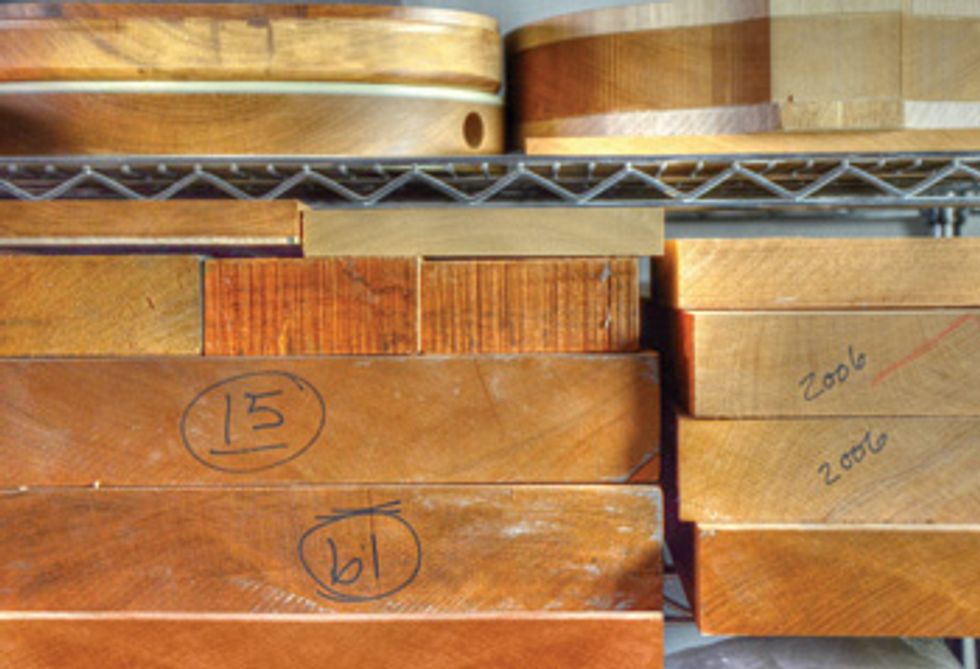Because wood is porous, even boards that have been carefully and correctly dried must be stored in a controlled environment or the moisture content will shift. We all love

Because wood is porous, even boards that have been carefully and correctly dried must be stored in a controlled environment or the moisture content will shift.
We all love to talk gear. If we didn’t, we wouldn’t be meeting like this. But when I hear statements like “the XYZ Brotherbucker totally slays the So-and-So Wonderbucker,” my hackles go up. Not because I don’t agree, but because I believe in more nuanced—and therefore useful—information. Gear-centric discussions are often fraught with what I call “raised-eyebrow moments.” I’m not sure if I actually pull out the trademark Belushi sneer but at least mentally, I’m saying to myself: “Are you effing kidding me?” Everyone has an opinion, and some are even prepared to back it up with measurable evidence. But because so much about what we enjoy about guitars is purely subjective, it makes the subject matter not only hard to prove, but also very personal, which explains the tendency to get militant about beliefs. So, in the interest of an even less-quantifiable factor at the core of every guitar worth mentioning, let’s discuss wood drying.
If you’ve seriously shopped for a premium instrument, you have most likely heard the term tonewood applied to the materials coveted by guitar builders (and even some musicians). It generally applies to the woods used to build musical instruments, usually those with strings such as violins, cellos, and guitars. The inherent effect of different wood species upon the tonality of an instrument is a never-ending discussion, but little is heard about how wood is prepared.
The idea of old wood has currency among builders, but unless properly seasoned, a board’s age is a worthless statistic. Labels like “air dried” and “century old” are suspect because these designations by themselves mean nothing. As we start to examine the actual science behind how wood gains and loses moisture, the fallacy of these sorts of terms becomes clear. The correct seasoning of wood that’s used for guitars is important, but exactly why is a bit opaque as viewed through the lens of marketing.
Why We Dry
Builders of all things wooden must be
concerned with moisture content for many
reasons. Most of the considerations are structural,
including the ability of glues or final
finishes to bond properly. Wood shrinks in
size as it dries, so it is important for pieces to
be stabilized before fitting them together in a
final form. Unlike a table or door, extremely
small changes in dimensions can cause playability
problems for a guitar. For all these reasons, it is important to bring instrument
wood into a state that will be at rest in “normal”
operating situations and environments.
Appropriate Moisture Content
To begin with, wood in its natural state is fairly
saturated with moisture in what is referred
to as sap. It’s the easy flow of this moisture
through the tree that nourishes its extremities,
much like our own body’s circulation
system. After a tree is felled, it no longer draws
moisture through a root system, but can still
absorb water from its surroundings. Even after
trees are cut into boards, the wood is at the
mercy of its environment. Moisture in boards
is found in the tube-like rays and vessels that supply food to the wood cells, as well as inside
the cells themselves. Transfer of waterborne
food to the cells is accomplished via small
gateways called pits, which act as valves. The
notable thing here is that this system can work
in either direction—gaining or losing moisture
in an effort to reach what is called equilibrium.
This fact is important because it means
that a board stored for decades in a humid
environment will not lose enough moisture to
be deemed usable for most furniture or musical
instrument purposes.
How We Dry
Most commercially available lumber is dried
to between 8 to 12 percent moisture content,
measured by weight in what is called the “dry
basis.” The most common method of achieving
this is by using a drying oven, or kiln. It’s
not just a matter of putting wood into a hot
room and waiting because there are a myriad
of variables to be aware of. Green (new)
wood can vary greatly in moisture content, ranging anywhere from 30 percent to as
much as 200 percent as a ratio.
Moisture is divided into two different categories: free water, which is found in the rays and vessels, and bound water, which is held in the cells themselves. Also, the material nearest the outside dries more quickly than the center of the board. The resulting vacuum instigates a capillary action that draws the internal moisture towards the surface. This aspect takes more time and requires more heat. But forcing any of these issues with too much heat too soon can destroy the wood with cracks, or leave the center wet—a structural time-bomb. Some experts insist that fracturing the cells or cooking the resin left behind by overenthusiastic drying can also change the resonance of the wood. Whether or not this is true, the structural reasons are enough to warrant tailoring the drying cycle to each individual load.
Beyond the Dry
Since wood is porous, even if a builder buys
wood that is carefully and correctly dried, it
must still be kept in a controlled environment
or the moisture content will drift.
This applies to the guitar in your home, too.
Maintaining a relative humidity of around
35 to 40 percent will keep your axe close
to the environment that it was (hopefully)
built in. It is important to note that some
of the drying parameters of commercial
lumberyards do not include considerations
of cell damage that may affect resonance
despite being structurally acceptable for furniture
applications. In those cases, structurally
sound has nothing to do with the sound
it makes!
In the end, it comes down to having a guitar or bass that functions properly and won’t shift too much during use. Beyond that, it has to do with resonance. Can any of this be discerned by ear? Not bloody likely. Does it matter? Sure, if your idea of getting your money’s worth includes your guitar’s maker raising the bar and understanding their craft. You decide. You may find yourself raising an eyebrow occasionally while reading about a potential purchase.
 Jol Dantzig is a
noted designer, builder,
and player who co-founded
Hamer Guitars,
one of the first boutique
guitar brands, in 1973.
Today, as the director of
Dantzig Guitar Design, he continues to
help define the art of custom guitar. To
learn more, visit guitardesigner.com.
Jol Dantzig is a
noted designer, builder,
and player who co-founded
Hamer Guitars,
one of the first boutique
guitar brands, in 1973.
Today, as the director of
Dantzig Guitar Design, he continues to
help define the art of custom guitar. To
learn more, visit guitardesigner.com.
